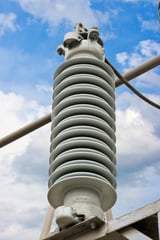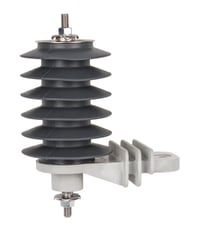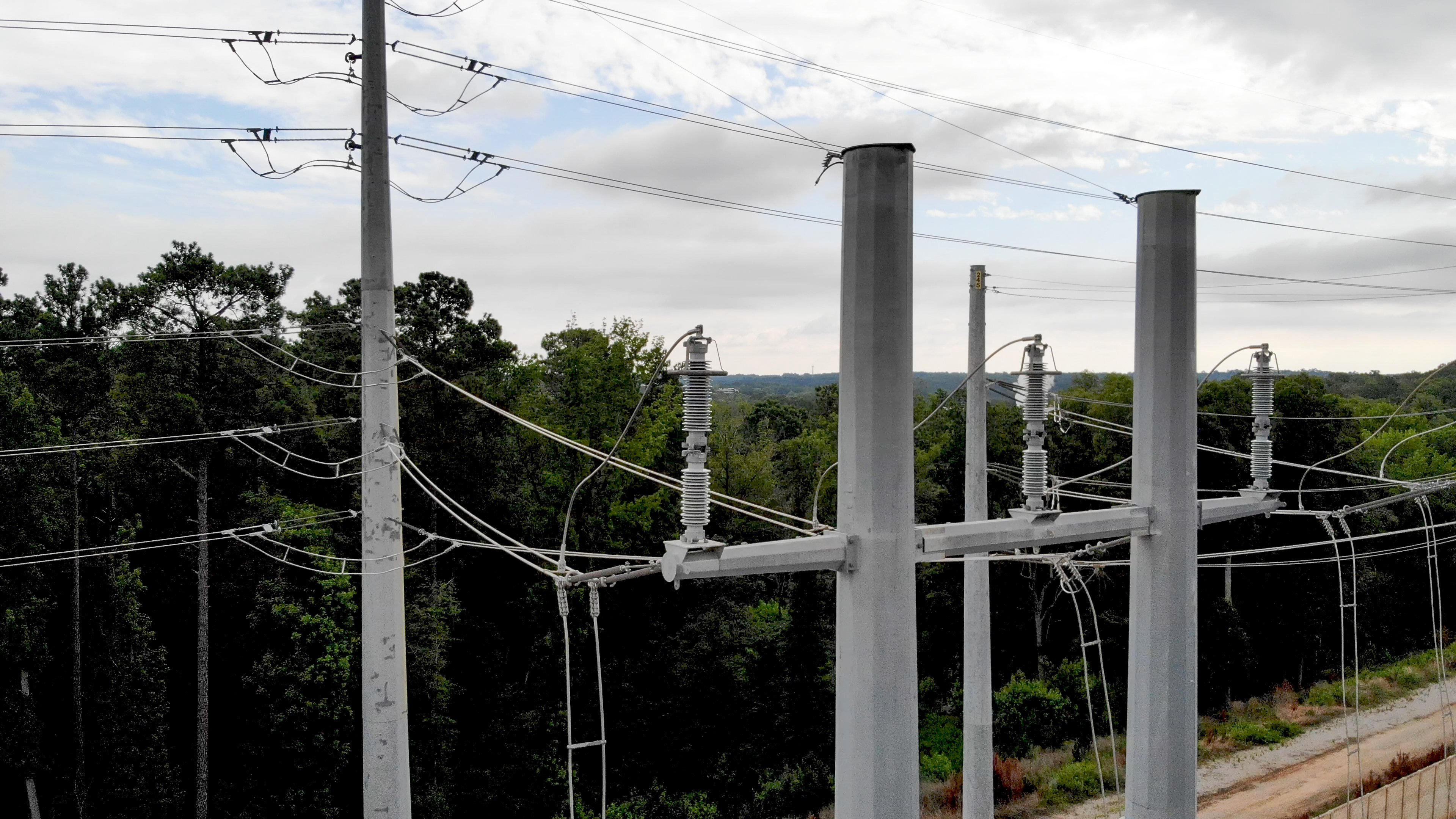 MOV, or metal-oxide varistor, surge arresters are widely applied to protect critical utility equipment and improve grid reliability. Surge arresters come in various designs to protect distribution, transmission and substation assets. The characteristics of the surge arrester are customized to meet the varying requirements of each application. IEEE and IEC standards govern the minimum requirements for all surge arresters, however other characteristics must be considered to meet Hubbell’s demanding quality standards.
MOV, or metal-oxide varistor, surge arresters are widely applied to protect critical utility equipment and improve grid reliability. Surge arresters come in various designs to protect distribution, transmission and substation assets. The characteristics of the surge arrester are customized to meet the varying requirements of each application. IEEE and IEC standards govern the minimum requirements for all surge arresters, however other characteristics must be considered to meet Hubbell’s demanding quality standards.
There are numerous traits that ensure the quality and longevity of MOV surge arresters. Five key characteristics tend to overshadow others. These include:
- MOV design and quality
- Housing material and associated moisture sealing
- Resistance to environmental conditions
- Testing
- Safety
The attributes of a reliable surge arrester ensure the maximum lifespan of vital utility equipment and help ensure lineman safety.
1. MOV design and quality
The MOV is the heart of all modern high voltage surge arresters. To ensure superior performance MOV manufacturing requires strict attention to quality control practices. Due to the critical importance of the MOV disc, Hubbell continues to manufacture MOV discs in-house at it’s U.S. based facility. While standards and guides exist for the design, manufacture and application of surge arresters, there is no such reference document for MOV discs. The material composition and method of manufacturing is strictly reliant on the manufacturer. Hubbell considers MOV manufacturing and the associated material science to be a core competency. MOV discs are manufactured in a wide range of heights and diameters. The composition of an MOV disc includes approximately 90% Zinc Oxide (ZnO) and 10% additives. Commonly used additives include Bismuth, Antimony, Nickel and Manganese. The amount of each additive has a critical effect on the varistor characteristics. Additional binders and organics are added to aid with MOV disc processing. Before the discs are released for shipment, the entire batch of sorted MOV discs is set aside for additional testing. Sample discs are selected for quality assurance tests to determine the properties of the batch. Hubbell engineers devised a sequence of testing that tests the mechanical and electrical limits of the discs, thus some discs must be sacrificed and are destroyed during testing. The associated batch of MOV discs will be released to production only when quality assurance targets are satisfied.

2. Arrester housing material and associated moisture sealing

Surge arresters can be characterized by numerous factors, but one of the most common is the insulation material. Porcelain originated as the dominant material for all applications. A paradigm shift in the design of arresters occurred in 1986 with the introduction of the first polymer housed surge arrester, a distribution design, by the Ohio Brass Company (now Hubbell). Various polymer materials and associated compounds are utilized in the utility industry. Polymer insulating materials for arresters are typically defined by the base material. There are three primary base materials available in the market: ethylene propylene (EP), dimethyl siloxane (silicone), and combinations of both. Combinations of the two materials have been developed to combine the resistance to erosion and tracking of an EP material with the hydrophobicity of a silicone-based material. Hubbell manufactures surge arresters and various other electrical components using a proprietary compound. The material, trade named ESP™, is made with a base material that is a combination of EPDM and low molecular weight silicone oil. This hybrid material is used for Hubbell distribution arresters and solid core station and intermediate arrester housings. The combination of the mechanical and electrical resistance of EPDM with the hydrophobicity of silicone rubber created a superior insulating material. Ohio Brass developed a series of critical tests to ensure the long-term performance and reliability of a polymer. These tests include oxidative stability, ultraviolet exposure, corona cutting, tracking and erosion and salt fog accelerated aging. Yet, the ultimate test for any polymer material is field exposure. Utilities have demonstrated the longevity of Hubbell polymer products for over 40 years. A testament to ESP is highlighted by the 35-year history of the PDV arrester line, which culminated with Hubbell shipping its 40 millionth polymer housed distribution surge arrester in 2020.
3. Arrester resistance to environmental conditions
IEEE and IEC standards define the standard operating conditions for MOV surge arresters. Exposure to conditions outside of these limits require special consideration in the design and application of surge arresters. Special application considerations include extreme temperatures, hurricane force winds, pollutants, and seismic conditions. With a full internal lab capability, Hubbell can perform critical tests to ensure products meet these demanding application requirements. Examples include thermal chambers that can expose arresters to maximum loading at temperatures ranging from -60°C to 60°C; test apparatus for validating high mechanical arrester designs with a certified continuous cantilever rating up to 178,500 in-lbs; a polymer lab capable of testing materials to failure in various conditions, as well as a high voltage lab where salt fog and contamination tests can be performed; Hubbell additionally has seismic certification on all station class arrester families. Seismic certification ensures arresters can withstand a 1.0 g earthquake at system voltage as high as 550 kV. Ensuring the arrester can survive these conditions and remain functional is key to ensuring longevity of the arrester and utility equipment.
4. Testing
A superior testing program ensures critical characteristics are verified, maintained and lead to the long-term performance of protected equipment. Hubbell engineers ensure all arresters manufactured meet industry, customer and internal Hubbell requirements. This includes type testing each product line to the latest edition of IEEE C62.11 and IEC 60099-4. Independent third-party type tests are additionally available for select products. Routine testing is conducted on every surge arrester before leaving the Hubbell facility. This ensures arresters are safe to install and meet all published values. Additional testing is performed on incoming raw material, components and MOV discs to ensure the highest quality products. Hubbell can provide type test reports and certifications for all aspects of testing.
5. Safety
Safety is sometimes the last, but yet can be the most important consideration when designing and installing surge arresters. Arresters rarely get overloaded in service and when it does occur this is a single event in the products lifespan. Hubbell certifies every arrester to various fault current conditions, including reclose operation. Conditions tested include rated short-circuit tests at 63 kA for all station arresters. While an arrester will only short circuit once in its lifetime, the pressure relief rating is a critical consideration. Verifying this parameter will ensure the safety of line crews, the general public and equipment.
High voltage surge arresters are a critical cog piece of equipment in the protection of a utility’s vital assets. Modern MOV type surge arresters have reached a mature state. Hubbell’s commitment to quality and these five key attributes guarantee their performance. Various arrester design types are available for protecting distribution systems, power transformers, circuit breakers, generators, and line insulation.


